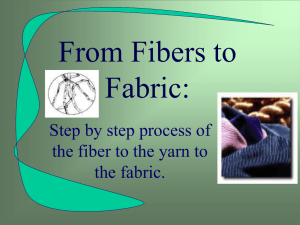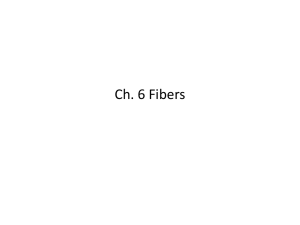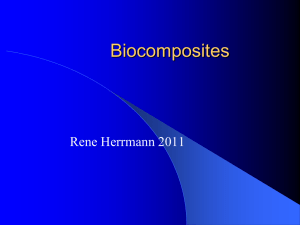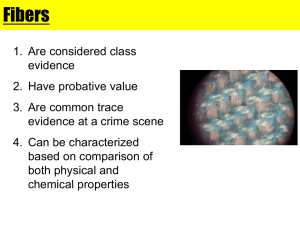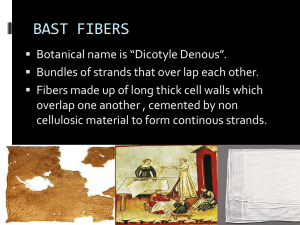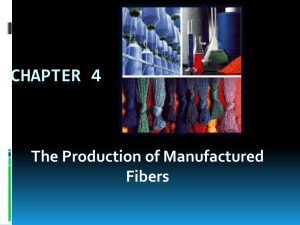Fibers
advertisement
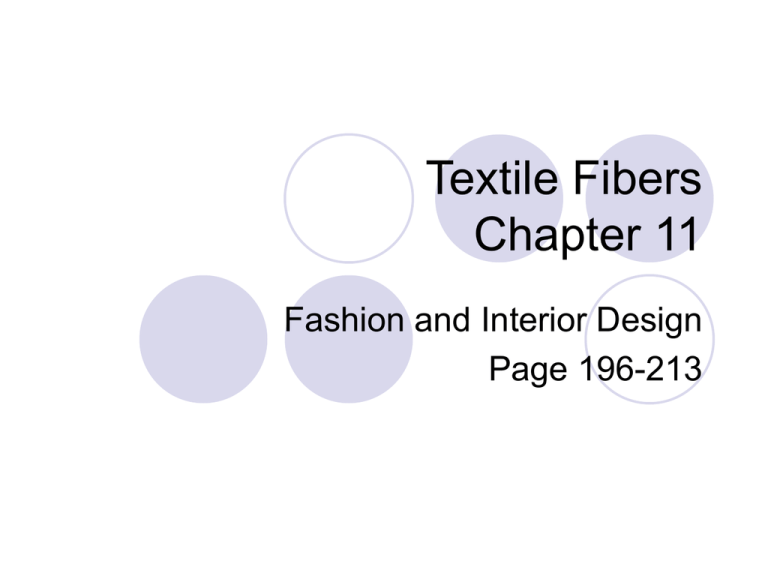
Textile Fibers Chapter 11 Fashion and Interior Design Page 196-213 Learning Targets I can classify various fibers and describe their characteristics, including the process of creating manufactured fibers. Vocabulary Abrasion Absorbent Fiber Generic Name Luster Manufactured Fibers Microfibers Natural Fibers Pill Resilient Tensile Strength Trade Name What Are Fibers? Fiber: the basic unit that makes fabric. Very similar to a very fine strand of hair. Fibers are usually grouped and twisted together to form a continuous strand called a yarn. By weaving or knitting yarns together, different textiles can be made. Classification of Fibers Natural Fibers: come from natural sources such as plants and animals. Manufactured Fibers: made from such substances as wood pulp, petroleum, natural gas, air, and water. (man-made or synthetic) A recent innovation in fiber research is the microfiber, which is 100 times finer than a strand of human hair. Fiber Names Generic Name: fiber name for a general classification of fibers of similar composition. (Cotton, Wool, Nylon, Rayon, Polyester) A fiber’s general name must be listed on the label of all textile products according to the Textile Fiber Products Identification Act. Trade Name: names for fibers registered as trademarks and protected by law. The 11 Characteristics of Fibers Strength Tensile Strengths: the ability to withstand tension or pulling. Durability Resiliency Resilient: able to spring back to shape after crushing or wrinkling. Elasticity Abrasion Resistance Abrasion: a worn spot that can develop when fibers rub against something. Pill: form tiny balls of fiber on fabric. Wrinkle Resistance Shape Retention Luster Luster: sheen or shine Absorbency Absorbent: able to take in moisture Wicking Wicking: the ability to pull moisture through spaces between the yarns and away from the body. (Dry fit) Washability Natural Fibers Plant Fibers: Cotton, Flax, Ramie Made from cellulose, a fibrous substance found in plants. Ramie is a natural fiber with properties of both silk and flax that comes from the stems of China grass. Animal Fibers: Wool, Silk, Cashmere, Angora All natural fibers are staple fibers except silk, which is a filament fiber. Staple Fibers: short fibers measured in inches or centimeters. Filament Fibers: a long fiber measured in yards or meters. Textile Fibers Identification Phase I: Fill out the requested information for each fiber on your Phase I Fiber Identification Chart using internet resources. Example: Fiber Name Advantages Disadvantages Care Uses Trade Name Cotton Extremely versatile; strong and durable; comfortable and soft; absorbs moisture; doesn’t cling or pill; dyes easily Not resilient or elastic; wrinkles unless treated; shrinks in hot water unless treated; will mildew; flammable Easily laundered at high temperatures; can be ironed at high temperature Shirts, sweaters, dresses, jeans, underwear, socks, diapers. Towels, sheets, placemats, napkins, curtains, upholstery. Not Applicable Textile Fibers Identification Phase II: Complete the visual, burning, and chemical observations for ten fabric samples that contain 100 percent of a given fiber, including 5 manufactured and 5 natural. Fabric samples, magnifying glasses, tweezers, Petri dishes, bleach, acetone, a candle, and aluminum foil will be provided for you to conduct your identification tests.
